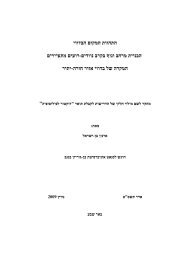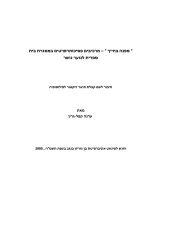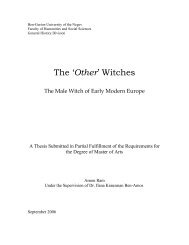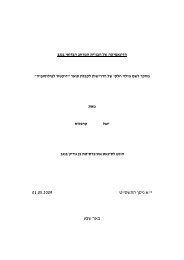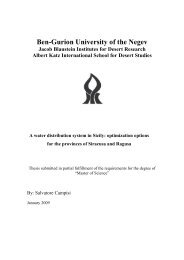רוח חן - אוניברסיטת בן-גוריון בנגב
רוח חן - אוניברסיטת בן-גוריון בנגב
רוח חן - אוניברסיטת בן-גוריון בנגב
Create successful ePaper yourself
Turn your PDF publications into a flip-book with our unique Google optimized e-Paper software.
iv<br />
Scientific study among Jews on Ashkenazi soil and Karaites living in<br />
Byzantium, Eastern Europe and Crimea depended mostly on texts which were<br />
written in Hebrew or translated into Hebrew in Southern France or Italy.<br />
Through this network of influence and cultural transfer, Rua˙ Óen and its<br />
perception as a highly-valued introductory text for Aristotelian sciences were<br />
passed on. The spreading of this image of Rua˙ Óen was a seminal factor that<br />
led to the fact that the study of Rua˙ Óen persisted throughout these cultural<br />
regions.<br />
Rua˙ Óen was brought to Ashkenaz in the second half of the fourteenth<br />
century at the latest, ostensibly from Italy. Shortly after, it was used by<br />
Ashkenazi scholars who sought to acquire basic Aristotelian scientific<br />
knowledge. By the sixteenth century its readership in the Ashkenazi cultural<br />
context increased, and local printed editions were published. During this entire<br />
period Rua˙ Óen played an essential role - at times an exclusive one - in<br />
Ashkenazi readers' acquisition of Aristotelian science.<br />
Rua˙ Óen gained particular popularity in the Karaite cultural contexts.<br />
During most of the period under discussion, the Karaites read hand-written<br />
copies of Rua˙ Óen. Manuscripts of the text had reached the Karaites in<br />
Byzantium already by the thirteenth century, via their Rabbanite neighbors,<br />
among whom the text had been popular between the thirteenth and fifteenth<br />
centuries. The manuscripts of Rua˙ Óen which were disseminated in these<br />
communities included distinctive additions, (e.g. poems, albeit not new<br />
scientific material) and paratexts that are almost never in manuscripts copied<br />
outside of the eastern Mediterranean Basin. From this Byzantine rabbinical<br />
branch of Rua˙ Óen manuscripts, a Karaite branch emerged. From the<br />
beginning of the seventeenth century, at the very latest, and throughout the<br />
following two centuries, many manuscripts of Rua˙ Óen circulated in the East-<br />
European and Crimean communities. Manuscripts of the text reached these





